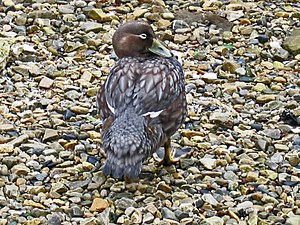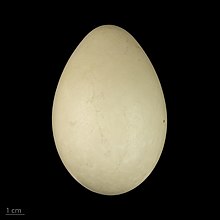Falkland steamship duck
| Falkland steamship duck | ||||||||||||
|---|---|---|---|---|---|---|---|---|---|---|---|---|

Falkland steamship duck ( Tachyeres brachypterus ) |
||||||||||||
| Systematics | ||||||||||||
|
||||||||||||
| Scientific name | ||||||||||||
| Tachyeres brachypterus | ||||||||||||
| ( Latham , 1790) |
The Falkland steamship duck ( Tachyeres brachypterus ) is a flightless and monotypical species of bird from the family of ducks (Anatidae) and belongs to the subfamily of demi-geese ( Tadorninae ). This species is a large, goose-like duck bird with a sturdy build and an overall very dark appearance. It only occurs in the Falkland Islands . It is not considered endangered.
Appearance
The species reaches a body length of 61 to 74 centimeters and a weight of 3.4 to 4.42 kilograms. The male has dark plumage on the body with the exception of the white belly and a white mirror on the wings, the head has gray feathers, the plumage on the lower part of the neck is sometimes light brown. The beak is colored orange and has a black tip. In the female, in contrast, the beak is yellow. Furthermore, females are usually much smaller than males. A sexual dimorphism is also present in relation to the plumage: Instead of the gray head as in the male, the head of the female is uniformly brown and only has a short white line behind the eye. Fledglings resemble adult females, but do not show a white line on the eye.
It can be confused with the long-winged steamboat duck, among other things . However, the Falkland Steamship Duck is larger and more massive than this species.
voice
Falkland steamship ducks are very callful birds. The male shouts cheeroo loudly and repeatedly , the pitch dropping . Repeated kek-kek-kek calls can also be heard from the male. The calls of the female are rather croaking. They call significantly higher than the male crek-crek-crek .
Way of life and distribution
The Falkland Steamship Duck is endemic to the Falkland Islands . There she inhabits the rocky coasts all year round and prefers sheltered bays and marine spots with dense seaweed vegetation . It is observed up to three kilometers from the coastline. It is widespread there and a common bird in many regions. In the interior, it occurs up to a distance of five kilometers from the coastline. In their way of life they are very strongly linked to salt water, but use fresh water near the coast for bathing and drinking. Falkland steamship ducks are very territorial birds and defend their territory against other pairs and other bird species all year round.
It finds its food by pounding and diving. Mostly it stays in shallow sea bays, but it also uses fresh water in the coastal area.
The breeding usually takes place between September and December. Like the closely related whitehead steamship duck, T. brachypterus also breeds near the water, but rarely in colonies, but without exception in single pairs. In addition to dense vegetation, abandoned breeding caves are often used as nesting places by penguins, which are padded beforehand. A clutch consists of 5–10 eggs that are incubated for 28–40 days. During the breeding season, the Falkland Steamship Duck is extremely territorial and aggressively defends its breeding area. However, it shows territorial behavior all year round. Only not yet sexually mature Falkland steamship ducks form small groups and are then occasionally associated with the long-winged steamship duck.
Marine crustaceans and mollusks , which are mainly caught diving and less often rooting, form the main component of the diet.
Duration
The IUCN classifies the Falkland steamship duck as not endangered ( least concern ). The distribution area is limited, but the population is estimated to be stable. Eggs are still being collected by humans for consumption, but the amount collected is small and has little or no impact on the overall population. The pollution of the coastal waters is a potential hazard, as the steamboat duck relies on marine invertebrates for food. Offshore oil production in particular is therefore a potentially highly threatening factor for the population if it results in major pollution of the sea.
supporting documents
literature
- Josep del Hoyo , Andrew Elliot, Jordi Sargatal : Handbook of the birds of the world. Volume 1: Ostrich to Ducks. Lynx Edicions, Barcelona 1992, ISBN 84-87334-10-5 .
- Hadoram Shirihai: A Complete Guide to Antarctic Wildlife - The Birds and Marine Mammals of the Antarctic Continent and Southern Ocean , Alula Press, Degerby 2002, ISBN 951-98947-0-5
- Robin and Anne Woods: Atlas of Breeding Birds of the Falkland Islands , Anthony Nelson, Shorpshire 1997, ISBN 0904614-60-3
Web links
- Videos, photos and sound recordings of Tachyeres brachypterus in the Internet Bird Collection
- Tachyeres brachypterus inthe IUCN Red List of Threatened Species 2013.2. Listed by: BirdLife International, 2012. Retrieved February 2, 2014.

